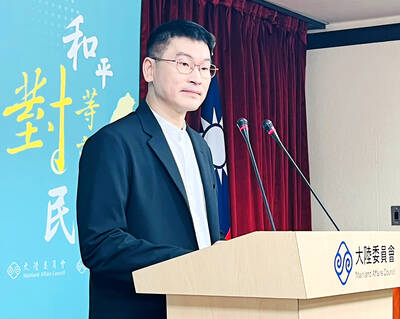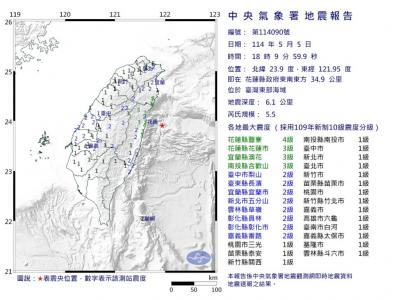Neil O'Maonaigh-Lennon has been teaching English in Taiwan since last February. His contract expires next month, but rather than pack his bag and leave quietly, O'Maonaigh-Lennon has something else in store.
"I decided to run one marathon a day for 30 consecutive days," he told the Taipei Times recently. "I want to leave Taiwan with a bang and run for a good cause."
In so doing, O'Maonaigh-Lennon hopes to raise funds for Cancer Research UK and the Taiwan Foundation for Rare Disorders.

PHOTO COURTESY OF NEIL O'MAONAIGH-LENNON
The idea of running for cancer did not come to him by accident.
"Cancer research was something that interested me all through my university years," he said. "Also, Terry Fox, the fight he went through, was another reason."
Fox -- sporting a prosthetic leg -- is famous for running the "Marathon of Hope" across Canada to raise funds for cancer research.
The run around the nation's coastline, scheduled to begin on April 1, will also lead O'Maonaigh-Lennon to some of the nation's best-known tourist attractions, including Taroko Gorge (太魯閣) in Hualien and the beaches of Kenting (墾丁).
To him, the grueling feat is just another exciting adventure.
O'Maonaigh-Lennon remembers watching the London marathon every year on TV when he was growing up in the capital. In 2002, he decided to run the race himself.
Since then, he has run 13 marathons on three continents, the most recent being the ING Taipei marathon in December.
"My ambition is to run one [marathon] in every continent," he said.
A year ago, O'Maonaigh-Lennon was offered the chance to teach in Asia and was given a choice between China and Taiwan. He chose Taiwan because he said it "is an island, like the UK."
O'Maonaigh-Lennon said that, before he arrived, he found it hard to believe how foreigners could live in Taiwan for seven or eight years.
"Now I can understand why," he said.
"Everyone here is friendly and willing to accept you and help you," he added. "[Taiwan] has a great social scene as well. For a single man, it is a lot to take in."
O'Maonaigh-Lennon will begin his trek at Fugueijiao (
He said that he would stay on or close to the coast, but occasionally move inland to see must-see scenic spots.
The Briton plans to start his day on the road at 7am and finish at 2pm so that he can have time to explore.
Whatever he sees, hears or encounters will become material for an online journal of his journey, which he hopes will help introduce Taiwan to the rest of the world.
A friend will ride alongside him on a scooter and make sure that he runs 42km every day, the standard distance for a marathon.
As the two are doing this at their own expense, they plan to sleep in school classrooms or camp outside to save money.
O'Maonaigh-Lennon said he would not be in a hurry and welcomes other runners to join him along the route.
He also said he had not set a goal on how much money to raise. Both organizations have donation links on their Web sites, so the money will go straight into registered accounts, he said.
"People can choose which organization they want to donate to," he said.
It is still more than a month before he starts the adventure. And although there are many things that could go wrong -- be it a leg injury or bad weather -- O'Maonaigh-Lennon said he was determined to accomplish his mission.
"I won't leave Taiwan without completing my 30-day marathon. I will stay until I finish it," he said.

An essay competition jointly organized by a local writing society and a publisher affiliated with the Chinese Communist Party (CCP) might have contravened the Act Governing Relations Between the People of the Taiwan Area and the Mainland Area (臺灣地區與大陸地區人民關係條例), the Mainland Affairs Council (MAC) said on Thursday. “In this case, the partner organization is clearly an agency under the CCP’s Fujian Provincial Committee,” MAC Deputy Minister and spokesperson Liang Wen-chieh (梁文傑) said at a news briefing in Taipei. “It also involves bringing Taiwanese students to China with all-expenses-paid arrangements to attend award ceremonies and camps,” Liang said. Those two “characteristics” are typically sufficient

A magnitude 5.9 earthquake that struck about 33km off the coast of Hualien City was the "main shock" in a series of quakes in the area, with aftershocks expected over the next three days, the Central Weather Administration (CWA) said yesterday. Prior to the magnitude 5.9 quake shaking most of Taiwan at 6:53pm yesterday, six other earthquakes stronger than a magnitude of 4, starting with a magnitude 5.5 quake at 6:09pm, occurred in the area. CWA Seismological Center Director Wu Chien-fu (吳健富) confirmed that the quakes were all part of the same series and that the magnitude 5.5 temblor was

The brilliant blue waters, thick foliage and bucolic atmosphere on this seemingly idyllic archipelago deep in the Pacific Ocean belie the key role it now plays in a titanic geopolitical struggle. Palau is again on the front line as China, and the US and its allies prepare their forces in an intensifying contest for control over the Asia-Pacific region. The democratic nation of just 17,000 people hosts US-controlled airstrips and soon-to-be-completed radar installations that the US military describes as “critical” to monitoring vast swathes of water and airspace. It is also a key piece of the second island chain, a string of

The Central Weather Administration has issued a heat alert for southeastern Taiwan, warning of temperatures as high as 36°C today, while alerting some coastal areas of strong winds later in the day. Kaohsiung’s Neimen District (內門) and Pingtung County’s Neipu Township (內埔) are under an orange heat alert, which warns of temperatures as high as 36°C for three consecutive days, the CWA said, citing southwest winds. The heat would also extend to Tainan’s Nansi (楠西) and Yujing (玉井) districts, as well as Pingtung’s Gaoshu (高樹), Yanpu (鹽埔) and Majia (瑪家) townships, it said, forecasting highs of up to 36°C in those areas